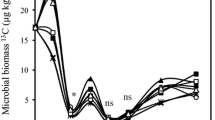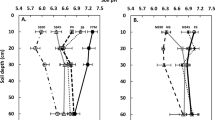Abstract
This study investigates the effects of residue incorporation coupled with plant growth and soil moisture level on wheat biomasses, soil nutrients, labile organic carbon (LOC), microbial metabolic profiles, and community composition. Four management practices were used in a 180-day pot experiment: (1) control (CON), (2) maize (Zea mays L.) residue incorporation without plants (MR), (3) wheat (Triticum aestivum L.) plants without maize residue (WP), and (4) maize residue incorporation with wheat plants (MRWPs). Each management practice included soil moisture at both 40 and 80% of field capacity. At wheat harvest, soil nutrient contents in the WP and MRWP treatments were significantly lower than in the CON and MR treatments. In comparison with the CON treatment, MR, WP, and MRWP treatments resulted in 35, 23, and 67% increases in dissolved organic carbon content; 17, 12, and 34% increases in hot-water extractable organic carbon content; and 78, 50, and 150% increases in microbial biomass carbon content. Furthermore, microbial utilizations of carboxylic acids and polymer carbon sources in the MR, WP, and MRWP treatments were 261 and 88%, 239 and 105%, and 300 and 126% higher than in the CON treatment. The MR and CON treatments had similar phospholipid fatty acid (PLFA) content but the WP and MRWP treatments had significantly increased gram-negative content and changes to community composition compared with the CON and MR treatments. The wheat biomass, LOC, and PLFA contents significantly increased with greater soil moisture. Overall, these results suggest an additive effect of residue incorporation and plant growth on LOC contents, primarily due to the changes in microbial utilization of carbon sources and community composition.


Similar content being viewed by others
References
Alarcón-Gutiérrez E, Floch C, Augur C, Le Petit J, Ziarelli F, Criquet S (2009) Spatial variations of chemical composition, microbial functional diversity, and enzyme activities in a Mediterranean litter (Quercus ilex L.) profile. Pedobiologia 52:387–399
Balasooriya WK, Huygens D, Denef K, Roobroeck D, Verhoest NE, Boeckx P (2013) Temporal variation of rhizodeposit-C assimilating microbial communities in a natural wetland. Biol Fertil Soils 49:333–341
Beales N (2004) Adaptation of microorganisms to cold temperatures, weak acid preservatives, low pH, and osmotic stress: a review. Compr Rev Food Sci Food Saf 3:1–20
Bhattacharyya P, Roy KS, Neogi S, Adhya TK, Rao KS, Manna MC (2012) Effect of rice straw and nitrogen fertilization on greenhouse gas emission and carbon storage in tropical flooded soil planted with rice. Soil Tillage Res 124:119–130
Bird JA, Herman DJ, Firestone MK (2011) Rhizosphere priming of soil organic matter by bacterial groups in a grassland soil. Soil Biol Biochem 43:718–725
Cambardella CA, Elliott ET (1992) Particulate soil organic-matter changes across a grassland cultivation sequence. Soil Sci Soc Am J 56:777–783
Christ MJ, David MB (1996) Temperature and moisture effects on the production of dissolved organic carbon in a Spodosol. Soil Biol Biochem 28:1191–1199
Cookson WR, Osman M, Marschner P, Abaye DA, Clark I, Murphy DV, Stockdale EA, Watson CA (2007) Controls on soil nitrogen cycling and microbial community composition across land use and incubation temperature. Soil Biol Biochem 39:744–756
Dakora FD, Phillips DA (2002) Root exudates as mediators of mineral acquisition in low-nutrient environments. Plant Soil 245:35–47
De Vries FT, Hoffland E, van Eekeren N, Brussaard L, Bloem J (2006) Fungal/bacterial ratios in grasslands with contrasting nitrogen management. Soil Biol Biochem 38:2092–2103
Degens BP, Schipper LA, Sparling GP, Vojvodic-Vukovic M (2000) Decreases in organic C reserves in soils can reduce the catabolic diversity of soil microbial communities. Soil Biol Biochem 32:189–196
Dungait JAJ, Kemmitt SJ, Michallon L, Guo S, Wen Q, Brookes PC, Evershed RP (2011) Variable responses of the soil microbial biomass to trace concentrations of 13C-labelled glucose, using 13C-PLFA analysis. Eur J Soil Sci 62:117–126
Fontaine S, Mariotti A, Abbadie L (2003) The priming effect of organic matter: a question of microbial competition? Soil Biol Biochem 35:837–843
Fontaine S, Henault C, Aamor A, Bdioui N, Bloor JMG, Maire V, Mary B, Revaillot S, Maron PA (2011) Fungi mediate long term sequestration of carbon and nitrogen in soil through their priming effect. Soil Biol Biochem 43:86–96
Frostegård A, Tunlid A, Bååth E (1993) Phospholipid fatty-acid composition, biomass, and activity of microbial communities from two soil types experimentally exposed to different heavy-metals. Appl Environ Microbiol 59:3605–3617
Garland JL, Mills AL (1991) Classification and characterization of heterotrophic microbial communities on the basis of patterns of community-level sole-carbon-source utilization. Appl Environ Microbiol 57:2351–2359
Ghani A, Dexter M, Perrott KW (2003) Hot-water extractable carbon in soils: a sensitive measurement for determining impacts of fertilisation, grazing and cultivation. Soil Biol Biochem 35:1231–1243
Grayston SJ, Griffith GS, Mawdsley JL, Campbell CD, Bardgett RD (2001) Accounting for variability in soil microbial communities of temperate upland grassland ecosystems. Soil Biol Biochem 33:533–551
Guckert JB, Hood MA, White DC (1986) Phospholipid ester-linked fatty-acid profile changes during nutrient deprivation of vibrio-cholerae—increases in the trans cis ratio and proportions of cyclopropyl fatty-acids. Appl Environ Microbiol 52:794–801
Haynes RJ (2005) Labile organic matter fractions as central components of the quality of agricultural soils: an overview. Adv Agron 85:221–268
Huang ZQ, Xu ZH, Chen CR (2008) Effect of mulching on labile soil organic matter pools, microbial community functional diversity and nitrogen transformations in two hardwood plantations of subtropical Australia. Appl Soil Ecol 40:229–239
Jones DL, Willett VB (2006) Experimental evaluation of methods to quantify dissolved organic nitrogen (DON) and dissolved organic carbon (DOC) in soil. Soil Biol Biochem 38:991–999
Kourtev PS, Ehrenfeld JG, Haggblom M (2003) Experimental analysis of the effect of exotic and native plant species on the structure and function of soil microbial communities. Soil Biol Biochem 35:895–905
Kuzyakov Y, Hill PW, Jones DL (2007) Root exudate components change litter decomposition in a simulated rhizosphere depending on temperature. Plant Soil 290:293–305
Li ZQ, Bingzi Z, Zhang JB (2016) Effects of maize residue quality and soil water content on soil labile organic carbon fractions and microbial properties. Pedosphere 26:829–838
Lu RK (1999) Methods of analysis on soil agricultural and chemical properties. China Agricultural and Scientific Technology Press, Beijing (in Chinese)
Merckx R, Vanginkel JH, Sinnaeve J, Cremers A (1986) Plant-induced changes in the rhizosphere of maize and wheat. 1. Production and turnover of root-derived material in the rhizosphere of maize and wheat. Plant Soil 96:85–93
Muhammad S, Muller T, Mayer J, Joergensen RG (2007) Impact of growing maize (Zea mays) on the decomposition of incorporated fresh alfalfa residues. Biol Fertil Soils 43:399–407
Nicolardot B, Denys D, Lagacherie B, Cheneby D, Mariotti M (1995) Decomposition of 15N labeled catch-crop residues in soil: evaluation of N mineralization and plant-N uptake potentials under controlled conditions. Eur J Soil Sci 46:115–123
Olsson PA (1999) Signature fatty acids provide tools for determination of the distribution and interactions of mycorrhizal fungi in soil. FEMS Microbiol Ecol 29:303–310
Paterson E, Osler G, Dawson LA, Gebbing T, Sim A, Ord B (2008) Labile and recalcitrant plant fractions are utilised by distinct microbial communities in soil: independent of the presence of roots and mycorrhizal fungi. Soil Biol Biochem 40:1103–1113
Ponizovsky AA, Metzler DM, Allen HE, Ackerman AJ (2006) The effect of moisture content on the release of organic matter and copper to soil solutions. Geoderma 135:204–215
Rosolem CA, Li Y, Garcia RA (2016) Soil carbon as affected by cover crops under no-till under tropical climate. Soil Use Manag 32:495–503
Söderberg KH, Probanza A, Jumpponen A, Bååth E (2004) The microbial community in the rhizosphere determined by community-level physiological profiles (CLPP) and direct soil- and cfu-PLFA techniques. Appl Soil Ecol 25:135–145
Steer J, Harris JA (2000) Shifts in the microbial community in rhizosphere and non-rhizosphere soils during the growth of Agrostis stolonifera. Soil Biol Biochem 32:869–878
Swift RS (2001) Sequestration of carbon by soil. Soil Sci 166:858–871
Williams MA, Rice CW (2007) Seven years of enhanced water availability influences the physiological, structural, and functional attributes of a soil microbial community. Appl Soil Ecol 35:535–545
Winding A, Hund-Rinke K, Rutgers M (2005) The use of microorganisms in ecological soil classification and assessment concepts. Ecotoxicol Environ Saf 62:230–248
Wu J, Joergensen RG, Pommerening B, Chaussod R, Brookes PC (1990) Measurement of soil microbial biomass C by fumigation extraction—an automated procedure. Soil Biol Biochem 22:1167–1169
Xu MG, Lou YL, Sun XL, Wang W, Baniyamuddin M, Zhao K (2011) Soil organic carbon active fractions as early indicators for total carbon change under straw incorporation. Biol Fertil Soils 47:745–752
Yu WT, Bi ML, Xu YG, Zhou H, Ma Q, Jiang CM (2013) Microbial biomass and community composition in a Luvisol soil as influenced by long-term land use and fertilization. Catena 107:89–95
Zelles L (1999) Fatty acid patterns of phospholipids and lipopolysaccharides in the characterisation of microbial communities in soil: a review. Biol Fertil Soils 29:111–129
Zhang HJ, Ding WX, Yu HY, He XH (2013) Carbon uptake by a microbial community during 30-day treatment with 13C-glucose of a sandy loam soil fertilized for 20 years with NPK or compost as determined by a GC-C-IRMS analysis of phospholipid fatty acids. Soil Biol Biochem 57:228–236
Zhao BZ, Zhang JB, Flury M, Zhu AN, Jiang QA, Bi JW (2007) Groundwater contamination with NO3-N in a wheat-corn cropping system in the north China plain. Pedosphere 17:721–731
Zhou XQ, Wu HW, Koetz E, Xu ZH, Chen CR (2012) Soil labile carbon and nitrogen pools and microbial metabolic diversity under winter crops in an arid environment. Appl Soil Ecol 53:49–55
Acknowledgments
Funding for the work was provided by the National Key Research and Development Program of China (2016YFD0200107, 2016YFD0300802), the earmarked fund for China Agriculture Research System (CARS-03), and the Science and Technology Service Network Initiative (KFJ-SW-STS-142-03).
Author information
Authors and Affiliations
Corresponding author
Additional information
Responsible editor: Zhihong Xu
Rights and permissions
About this article
Cite this article
Li, Z., Zhao, B., Hao, X. et al. Effects of residue incorporation and plant growth on soil labile organic carbon and microbial function and community composition under two soil moisture levels. Environ Sci Pollut Res 24, 18849–18859 (2017). https://doi.org/10.1007/s11356-017-9529-9
Received:
Accepted:
Published:
Issue Date:
DOI: https://doi.org/10.1007/s11356-017-9529-9




